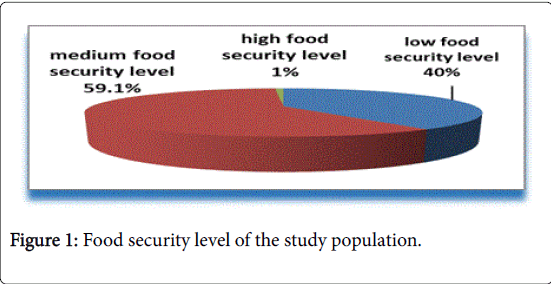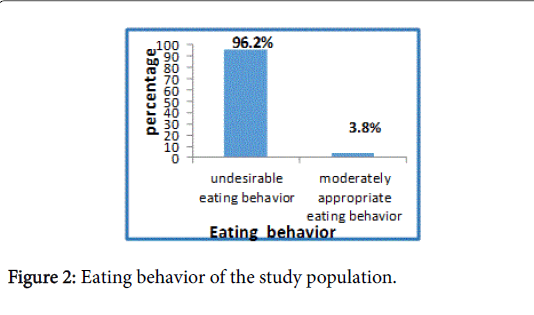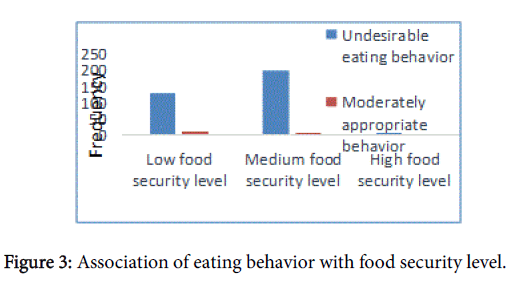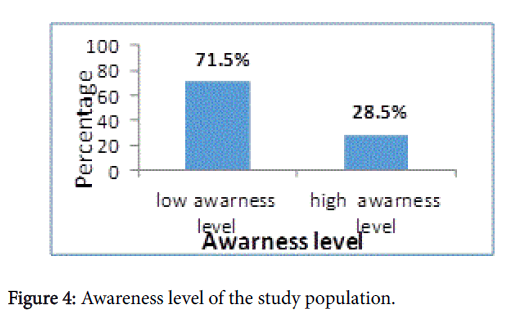Research Article Open Access
Evaluation of Food Security, Eating Behavior and Awareness of Low Socio-Economic Lebanese Women Living in Akkar
Mahfouz Rana, Matta Joane and Sacre Yonna*
Department of Agricultural and Food Sciences, Holy Spirit University of Kaslik, B. P. 446 Jounieh, Lebanon
- *Corresponding Author:
- Sacre Yonna
Faculty of Agricultural and Food Sciences
Holy Spirit University of Kaslik
B. P. 446 Jounieh, Lebanon
Tel: 9613568402
E-mail: yonna.sacre@gmail.com
Received date: October 21, 2016; Accepted date: November 12, 2016; Published date: November 19, 2016
Citation: Mahfouz R, Joane M, Yonna S (2016) Evaluation of Food Security, Eating Behavior and Awareness of Low Socio-Economic Lebanese Women Living in Akkar. J Comm Pub Health Nurs 2:141. doi:10.4172/2471-9846.1000141
Copyright: © 2016 Mahfouz R, et al. This is an open-access article distributed under the terms of the Creative Commons Attribution License, which permits unrestricted use, distribution, and reproduction in any medium, provided the original author and source are credited.
Visit for more related articles at Journal of Community & Public Health Nursing
Abstract
Background: Poverty in developing and low socioeconomic areas has an important consequence on women’s food supply. Therefore, food security and eating behavior among individuals living in these conditions could be altered due to social and economic status. Consequently, it is crucial to evaluate the “Food security, eating behavior and awareness of Lebanese women living in low socio-economic areas-Akkar”.
Objective: The purpose of this analysis is to evaluate these factors in women living in low socioeconomic areas in order to assess and compare their food intake to the food pyramid recommendations and to determine their awareness level regarding the healthy eating habits and how it is affecting their food choices.
Methods: A cross sectional study was conducted on randomly selected 340 women living in Akkar-North Lebanon, aging between 20 and 60 years old and showing a crowding index above 1. Data were collected through a validated questionnaire. Statistical analysis was carried out using the Statistical Package for Social Science (SPSS, version 16) with p<0.05. Several bivariate and multivariate models were used to evaluate the association between some independent variables and the food security, eating behavior and awareness of the study population.
Results: Among the participants whose average of body mass index is 25.76 ± 5.241 kg/m2, 99.1% are food insecure and are unable to access food. Factors such as age, women’s type of work, husband’s salary, crowding index and others affect food security and eating behavior. In addition, 96.2% of the study sample is adopting unhealthy eating behavior which could potentially lead to chronic health problems. Moreover, 71.5% are showing a low awareness level concerning the health importance of good eating habits; thus, this poor awareness level is significantly affecting the population food choices.
Conclusion: Future national studies and programs could be settled to increase the awareness about food security and good eating practices among this specific category of the Lebanese population and reduce food insecurity risk in this specific population.
Keywords
Lebanese women; Low socioeconomic; Crowding index; Food security; Eating behaviour; Awareness
Introduction
Poverty plays a crucial role in determining the extent of food security or insecurity [1]. Food insecurity exists when more than one household’s member is suffering from scarce money is unable to have food access in terms of variety and quantity [2]. It is the outcome of economic resources restriction [3]. Food insecurity is the decline in the frequency of food and nutrient levels, affecting individual’s nutritional status [4]. Furthermore, it has been associated with poverty, low income, overweight and obesity [5] as well as with lack of education, elevated crowding index [6] and unemployment [7]. In fact, food insecurity affects negatively the social, psychological and physical levels of individuals and households [7]. The impacts of food insecurity can be explained by dietary intake restrictions and low nutrient intake levels when healthy food is consumed in fewer portions. Numerous studies were conducted to find the association between food insecurity, socio-demographic factors and eating behaviors in disadvantaged areas. The association of food insecurity and a poor quality diet was supported in a study that showed that insecure women had low protein consumption from sources like fish as well as low fruits and vegetables consumption being a 338 g/d compared to minimum needed of 400 g/d [8].
Low income and food prices are essential factors of food insecurity, food choices and diet as they influence food purchasing [9,10]. Therefore, low socio-economic women rarely eat a healthy diet, they have inadequate diet and food intakes and their daily life and wellbeing are influenced by their eating behavior [9]. Moreover, poor women have higher consumptions of lower costs dense-energy food like fatty food and sweets that are positively associated with women total energy intakes and therefore increased weight; whereas higher socio-economic women have higher consumption of higher costs dense-energy food like fruits, vegetables and meat [9]. A poor nutrition like having a low consumption of fruits and vegetables is related to an increased risk of overweight and obesity [11]. Studies have shown that food insecurity is positively associated with overweight and obesity in developed countries [12]. Diet is influenced by individual’s socio-economic status, knowledge and attitudes towards these behaviors. Education was positively linked to food insecurity and eating behaviors in Jordan where results showed a positive association of education, nutrition knowledge, low income and low vegetables and fruit consumption as well as diet quality [13]
In Lebanon, Akkar is considered as a low socio-economic area in which the population could be facing nutritional problems due to the low access to food. In addition, studies concerning food insecurity and eating behavior in Lebanon, targeting Lebanese are limited, therefore the results of this current research could be of added value to the scientific literature.
Materials and Methods
Study design and sample size
This study is a cross sectional descriptive study in which quantitative and qualitative data were collected through a validated and pretested questionnaire, based on the California women’s Health Survey [14] to evaluate the food security, eating behavior and awareness of low socio-economic Lebanese women living in Akkar. The study population was constituted of 340 randomly selected low socio-economic, non -pregnant Lebanese women living in Akkar on altitudes below 600 and between 600-1200 m, having a crowding index above or equal to 1, aging between 20 and 60 years and healthy with no major health conditions such as cancer or other critical conditions. To those participants, consent letters were distributed in order to receive their approval to participate in the study.
The interviews
A 24 h recall and anthropometric measurements were also used along with the survey. The questionnaire was divided into different parts and included 83 questions, some of which food frequency questions that are related to the frequency and quantity of the different food groups consumed such as starch, meat, fruits and vegetables and others. Food models and measuring cups were used in order to accurately estimate the food quantities consumed expressed in grams. The interviewees were asked to estimate the number of times they consumed the food in question per day and per week. Then the quantity and the frequency factors were multiplied to obtain the general amount of food consumptions that was later divided into 3 intervals like low consumption, low to medium and medium to high consumption. The general consumption of food will be compared to health dietary guidelines and food pyramid in the part of results and discussion. Moreover, a 24 h recall was used to obtain more details concerning women eating behavior, by accessing their cooking methods and food-related activities. Anthropometric measurements were another tool used in this study, where the height was measured to the nearest cm with a measurement tape and the weight was measured with a digital weight scale and BMI was then calculated. Additionally a non-stretchable measuring tape was used to measure the midarm circumference as well as the skinfold caliper used to measure cutaneous folds. The body fat percentage was calculated following the Heymsfield formula [15]. Then women were classified according to the body fat percentiles into categories describing their nutritional status. The purpose of the study is to see if different factors like socioeconomic, socio-demographic and others are affecting the food security, eating behavior and awareness of those women. The awareness level was assessed through questions regarding nutrition knowledge, importance of physical activity, major sources of some vitamins and minerals and other questions. Women were then categorized into low, medium and high awareness levels. The research was conducted in the district of Akkar which is located in the North of Lebanon, 112 km away from Beirut, with Halba being its capital. It is the second major agricultural plain in the country in terms of size and importance. Akkar is divided into six main sections: Al Sahel, Middle and Higher Dreib, Joume, Shaffat and Qaiteh [16]. It is one of the most deprived and marginalized regions in Lebanon with 63% of poverty among household [16].
Statistics
Bivariate analysis was performed using one way ANOVA, Chisquare (χ2) and Fisher’s test. The multivariate analysis was assessed based on the logistic regression .Statistical analysis was executed using the statistical Package for Social Science (SPSS, version 16) and p<0.05. Frequencies and descriptive statistics were conducted, continuous quantitative variables such as BMI were described as per mean and SD, whereas the qualitative variables were noted as percentage (%) and frequency (N).
Results and Discussion
As a description of the study population, 87.9% are unemployed, married women, aged between 31 and 40 years old. They are illiterate or have attended primary school levels. Nearly half of our sample had more than 5 children and a crowding index higher than 1. Crowding index is positively linked to food insecurity (p=0.023). A high crowding index could be explained by the fact that women get married at early age and because of cultural and religious reasons such as polygamy [17]. Concerning women’s husbands, the majority are employed with salaries ranging between 200 $ and 500 $ which are lower than the estimated national poverty line defined in 2008 by the UNDP. In what is related to BMI, the average BMI of the study population is 25.76 ± 5.241, which indicates that they are at the upper limit and very close to become overweight. 34.4% of food insecure women are obese with BMI>30 or are overweight with <25 BMI<29.9. Studies explain high BMI and obesity by the cycle of hunger, deprivation and overeating [18]. Moreover, it could be the consequence of an inactive life; 86.2% of study population don’t exercise and have bad eating behavior. The majority of women are food insecure, 59.1% show medium security level and 40% have low security levels (Figure 1). Women at ages up to 40 are at higher risk of being insecure, since they could have small children who still depend on them, they compromise food to feed their children. In addition 96.2% show undesirable eating behavior (Figure 2), these results when compared to the pyramid, indicate a medium starch consumption, a low fruit and vegetables consumption, a low meat consumption and a high frequency consumption of grains. In addition this undesirable eating behavior is positively associated with food security levels (Figure 3). Furthermore, 71.5% have low awareness levels regarding nutrition and dietary guidelines (Figure 4).
Concerning the association of different variables with food security, it could be stated that income is positively associated with food insecurity level (p=0.000), since men are the major contributors to money, their salaries classify the socio-economic status of a household. Regarding the effect of different food group’s consumption and food security, it could be noted that fruits and vegetables consumption didn’t have significant association with food security. Whereas starch was significantly associated with security level (p=0.04). Medium starch consumption is 7 to 11 servings/day without considering the high frequency of grains consumption. Low socio-economic households tend to replace the more costly by cheaper food. Meat consumption is positively associated with food security (p=0.05). Meat is an expensive animal protein; low-income households cannot afford to buy it frequently. Regarding women’s eating behavior, approximately all of them are showing undesirable eating behavior and particularly women aging between 30 and 41 (97.30%). This association is nearly significant (p=0.06), since these women are married at an early age, therefore they will be in charge of young infants and children; so they will tend to sacrifice their food for their children and consequently will have modified eating behavior. Education is positively associated with low eating behavior as well (p=0.02), where both illiterate (95.80%) and primary level educated women (98.20%) experience low eating behavior. Women who are uneducated or have low education level tend to have less knowledge about healthy eating pattern and healthy lifestyle. Highly significant association of total starch consumption with adverse eating behavior (p=0.000) starchy food is cheap compared to more nutritious food. Bread is the most essential food commodity for households, in fact women tend to eat nearly all food during meals with bread. Not to forget the frequency of gains consumption per week (3 to 4 times per week), they usually eat grains on lunch and dinner to save time for preparation and money. An association between meat consumption and undesirable eating behavior is statistically positive (p=0.02). Low socio-economic women buy lower cost food, thus they rely on grains as sources of protein, since animal proteins like meat are more expensive. Food security level is positively associated with the eating behavior (p=0.04) as showed others studies [9]. Low consumption of meat is positively associated with health conditions primarily to anemia and metabolic syndrome (p=0.04). For insecure women meat, chicken and fish by far more expensive food compared to grains that are cheaper and have longer shelf lives. Regarding awareness, results show a high significant association between the level of education and the awareness level (p=0.000). This means that awareness level is higher in women who have a higher level of education as showed the participants who had less than 12 years of education and were at a higher risk of being foodinsecure compared to those who had a college degree [13]. After confounding different factors, women aging up to 40 years as well as married have more risk to be food insecure than older women or single (OR 2.11>1). In addition, husbands whose salaries are ranging between 200 $-500 $ are 5 times at higher risks than individuals with higher salaries (OR 5.55>1) (Table 1). High starch consumption increases the risk of unhealthy eating behavior two times more than low and medium starch consumption (OR 1.52) (Table 2). Women living in higher altitudes (600-1200 m) are at higher risk to have low awareness compared to the one living <600 m. (Table 3). The results found are of added value to the scientific literature since no studies are conducted in Lebanon concerning food security, eating behaviors and awareness of low socio-economic Lebanese women. Throughout the study we have faced limitations like the compliance rate and accuracy of women’s answers regarding their eating behavior and whether they are receiving or not donations. While some women believed that this survey could lead to assistance aids, they denied the donations received what could mask the effects of poverty on their food security. Likewise, difficulties in collecting anthropometric data because of winter season’s clothes and to cultural reasons when some women couldn’t allow taking measures related to their body fat that could be affected by their low eating behavior.
| Odds Ratio | p value | [95 % confidence interval] | |
|---|---|---|---|
| Age | |||
| 20<age<30 | 1 | ||
| 31<age<40 | 2.11 | 0.01 | 0.560-2.506 |
| 41<age<50 | 0.78 | ||
| 51<age<60 | 1.07 | ||
| Marital status | |||
| Single | 1 | ||
| Married | 3.38 | 0.04 | 0.830-9.57 |
| Divorced | 1.24 | ||
| widowed | 0.7 | ||
| Husband salary | |||
| Salary <200 $ | 1 | ||
| 200<Salary range<500 $ | 5.55 | 0.51-8.3 | |
| 500<Salary range<666 $ | 2.08 | 0.05 | 0.67-11.65 |
| Salary range> 666$ | 0.8 |
Table 1: Multivariate analysis between food security and independent
variables.
| Odds Ratio | p value | [95 % confidence interval] | |
|---|---|---|---|
| Level of education | |||
| Illiterate | 1 | ||
| Primary graduate school | 2.09 | <0.001 | 0.51-4.1 |
| Complementary graduate school | 0.21 | 0.06-0.74 | |
| Secondary graduate school | 0.09 | 0.02-0.39 | |
| University graduate | 0.07 | 0.02-0.39 | |
| Total starch consumption | |||
| Low starch consumption | 1 | ||
| Medium starch consumption | 0.26 | 0.03 | 0.07-0.91 |
| High starch consumption | 1.52 | 0.72-2.63 |
Table 2: Multivariate analysis between eating behavior and independent variables.
| Odds Ratio (OR) | p value | [95 % confidence interval] | |
|---|---|---|---|
| Altitude | |||
| <600 m | 1 | 0.001 | |
| 600-1200m | 2.62 | 0.008 | 1.28-5.39 |
Table 3: Multivariate analysis between awareness and independent variables.
Conclusion
The results of this study confirm the findings of the literature on one hand, and reject some others in the other hand. Different factors were associated with food security, eating behavior and awareness. Food insecurity is highly prevalent among Lebanese women living in Akkar. They show unhealthy eating behavior which is affected by low food security level, besides they have low awareness levels concerning a healthy eating pattern that is affecting their food choices. Age, marital status, employment, husband’s salary and crowding index affect food security. Also, marital status, level of education, affect eating behavior. Low meat consumption, medium starch consumption and eating behavior are associated. Moreover, food security and eating behavior are associated as well as low meat consumption and health conditions. Awareness was associated with education levels. The study results could be presented to the concerned governmental parties in order to suggest national policies aiming to decrease the food insecurity levels in women. Besides, programs could be settled in order to increase the awareness about food security and good eating practices. In future studies, it is valuable to assess practically women health status by conducting laboratory tests to evaluate the nutritional status and deficiencies of micronutrients and macronutrients and to assess women’s psychological status that is affected by food insecurity.
References
- Food and Agriculture Organization (FAO) (2013) Gender Equality and Food Security Women’s Empowerment as a Tool against Hunger.
- Tarasuk V, Mitchell A, Dachner N (2014) Household food insecurity in Canada, 2012. Research to Identify Policy Options to Reduce Food Insecurity (PROOF), Toronto.
- Pinstrup-Andersen P (2009) Food security: definition and measurement. Food security 1: 5-7.
- Barrett CB (2010) Measuring food insecurity. Science 327: 825-828.
- Ivers LC, Cullen KA (2011) Food insecurity: Special considerations for women. Am J Clin Nutr 94: 1740S-1744S.
- Huet C, Rosol R, Egeland GM (2012) The prevalence of food insecurity is high and the diet quality poor in Inuit communities. J Nutr 142: 541-547.
- Holben D (2010) Position of the American dietetic association: Food insecurity in the United States. Journal of the American Dietetic Association 110: 1368-1377.
- Bocquier A, Vieux F, Lioret S, Dubuisson C, Caillavet F, et al. (2015) Socio-economic characteristics, living conditions and diet quality are associated with food insecurity in France. Public Health Nutr 18: 2952-2961.
- Mello J A, Gans KM, Risica PM, Kirtania U, Strolla LO, et al. (2010) How is food insecurity associated with dietary behaviors? an analysis with low-income, ethnically diverse participants in a nutrition intervention study. Journal of the American Dietetic Association 110: 1906-1911.
- Foley W, Ward P, Carter P, Coveney J, Tsourtos G, et al. (2010) An ecological analysis of factors associated with food insecurity in South Australia, 2002-7. Public Health Nutr 13: 215-221.
- Drewnowski A (2009) Obesity, diets, and social inequalities. Nutr Rev 67 Suppl 1: S36-39.
- Jolliffe D (2011) Overweight and poor? on the relationship between income and the body mass index. Economics & Human Biology 9: 342-355.
- Bawadi HA, Tayyem RF, Dwairy AN, Al-Akour N (2012) Prevalence of food insecurity among women in northern Jordan. J Health Popul Nutr 30: 49-55.
- Adams EJ, Grummer-Strawn L, Chavez G (2003) Food insecurity is associated with increased risk of obesity in California women. J Nutr 133: 1070-1074.
- Gallagher D, Heymsfield SB, Heo M, Jebb SA, Murgatroyd PR, et al. (2000) Healthy percentage body fat ranges: An approach for developing guidelines based on body mass index. The American journal of clinical Nutrition 72: 694-670.
- Mouchref A (2008) Forgotten Akkar: Socio-economic reality of the Akkar region. Lebanon: MADA Association 1-32.
- Walker JA (2012) Early marriage in Africa–trends, harmful effects and interventions. African Journal of Reproductive Health 16: 231-240.
- Olson CM, Bove CF, Miller EO (2007) Growing up poor: long-term implications for eating patterns and body weight. Appetite 49: 198-207.
Relevant Topics
- Chronic Disease Management
- Community Based Nursing
- Community Health Assessment
- Community Health Nursing Care
- Community Nursing
- Community Nursing Care
- Community Nursing Diagnosis
- Community Nursing Intervention
- Core Functions Of Public Health Nursing
- Epidemiology
- Epidemiology in community nursing
- Health education
- Health Equity
- Health Promotion
- History Of Public Health Nursing
- Nursing Public Health
- Public Health Nursing
- Risk Factors And Burnout And Public Health Nursing
- Risk Factors and Burnout and Public Health Nursing
Recommended Journals
- Epidemiology journal
- Global Journal of Nursing & Forensic Studies
- Global Nursing & Forensic Studies Journal
- global journal of nursing & forensic studies
- journal of community medicine& health education
- journal of community medicine& health education
- Palliative Care & Medicine journal
- journal of pregnancy and child health
Article Tools
Article Usage
- Total views: 10751
- [From(publication date):
November-2016 - Dec 19, 2024] - Breakdown by view type
- HTML page views : 10000
- PDF downloads : 751




